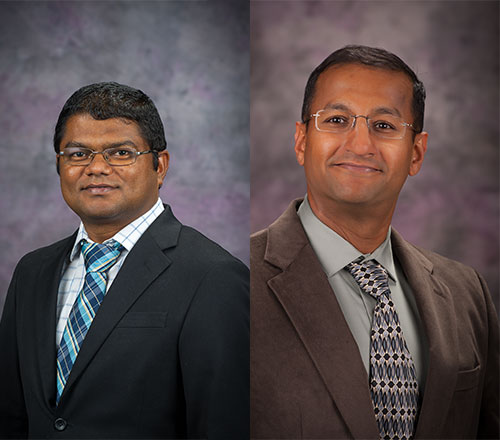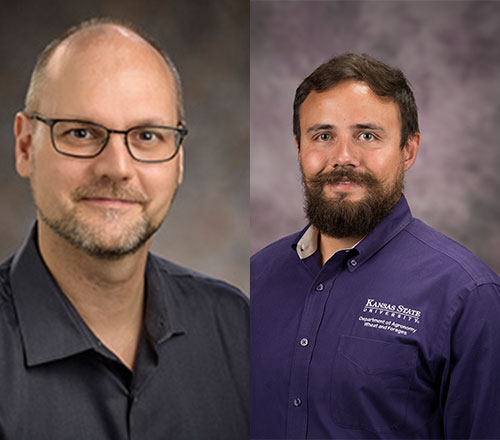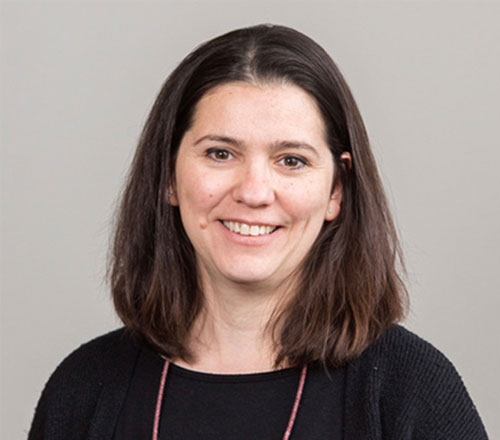Game-changing Research Initiation Program
Transdisciplinary teams for transformative research
2023 GRIP award team leaders

"Science and Technology Center for Greenhouse Gas Smart-Sensing and Mitigation for Kansas Climate and Agriculture (GHG SmartSense STC)."

"Towards a Global Food Systems Data Hub: Seeding the Center for Sustainable Wheat Production."

"Development of Resilient Urban Food Systems That Ensure Food Security in the Face of Climate Change."
Learn about GRIPex: AI in the Disciplines.
About the progam
*New pre-proposals are not currently being accepted.
Solutions to the global grand challenges facing our people, society, and the planet can best be found by the creation and deployment of successful transdisciplinary teams. The Office of the Vice President for Research, or OVPR, is partnering with the Office of the President, the Office of the Provost, the KSU Foundation and the college deans to help form and support impactful research teams that can provide solutions to our Kansas stakeholders, our nation, and our world. Under this new initiative, we anticipate funding the most promising interdisciplinary teams to conduct transformative research that may also have a positive impact on Kansas economic growth and prosperity, in pursuit of the goals articulated in K-State’s Economic Prosperity Plan.
This opportunity is open to all K-State faculty, departments, colleges, and campuses.
A total of $3M will be made available for this initiative. Proposals from transdisciplinary research teams are invited for up to $300K per year for up to three years. An additional $50K of ramp-up funding will be provided prior to the official start of the first year ($950K total per project). We anticipate funding up to three teams/projects. The remaining $150K will be used to seed promising but not yet competitive projects.
A core expectation of this program is to identify and support teams committed to developing competitive center-level proposals (federally funded, industry supported, or a combination or both) and/or contributing directly to statewide economic development.
The Office of Research Development, or ORD, is available, if needed, to assist proposal leaders/teams in identifying faculty experts from across K-State. ORD staff can point proposal leaders/teams to specific faculty members having complementary/contributing expertise or direct them to someone that can help identify the right faculty expert(s) and/or potential collaborators. Contact: ord@k-state.edu
GRIP proposals are invited on any topic, provided they meet at least one of the stated goals for the GRIP program, namely:
- Groundbreaking, transdisciplinary research
- Potential for economic development.
At least one of the GRIP awards will align with one or more of the thematic areas that have been identified in K-State’s Economic Prosperity Plan.
Successful proposals will also identify how the research will contribute to existing or new academic programs, both disciplinary and transdisciplinary; outreach to external stakeholders; corporate partnerships; and/or the launch of startups.
GRIP funds may also be used to plan or launch a new center; however, new centers will only be allowed to continue with sustainable extramural funding.
GRIP proposal teams must include an identified tenured faculty leader with demonstrated record of assembling interdisciplinary research teams, and both a leadership plan and a team science/synergy plan that appropriately share resources and responsibilities among faculty from multiple K-State colleges and/or campuses. Faculty and scientists from institutions or organizations outside of K-State may be include if their participation strengthens the proposal. If appropriate, a member of the KSURF staff can be included on the proposal team on the full proposal.
Support to be provided:
- Up to $300K per year for up to three years, plus $50K in one-time ramp-up funds, that includes a required contribution of $67K per year from the participating college(s); annual renewal subject to review of progress and meeting of specific milestones identified in the proposal. For proposals requesting less than $300K per year, the participating college(s) are required to provide 20% of the annual funding.
- Center grant proposal development assistance if needed.
- KSURF assistance to develop specific industry engagement and economic development aspects, if applicable.
- Regular meetings with KSU Foundation staff to develop a strategy for identifying/securing philanthropic support, if applicable.
- A negotiated sharing of SRO returned to the lead college(s) from any new federal grants supporting a new center will be provided to the project team, subject to approval of the VPR.
- Commitment of startup space for a new company that evolves out of the research at reduced cost for up to two years, if applicable
GRIP proposals must include specific plans — including timelines and target agencies — for one or more large center grant proposals and, where appropriate, a list of any participating personnel or organizations outside of K-State. If appropriate, proposals may include specific plans for a collaborative research agreement with one or more companies that results in location of facilities/employees in the Manhattan area or elsewhere in Kansas, and that result in significant new investments in K-State research, researchers, and facilities.
Proposals should also include statements of additional financial support — beyond the required match — any other types of support from participating colleges and any additional direct financial support from industry partners.
Pre-proposals will be reviewed by a broadly representative committee of senior researchers and academic leaders at K-State — identified once the pre-proposal topics and team members are known and including representation from all colleges. Invited full proposals will be reviewed by a broadly representative committee of faculty and academic leaders at K-State — identified once the final proposal topics and team members are known and including representation from all colleges — representatives from any relevant state agencies, and external experts invited to serve as reviewers. The committee will be assembled and charged to provide their ranked recommendations to the VPR. The VPR will make final decisions on awards in consultation with the president, provost, and Foundation.
Timeline:
Announcement of GRIP funding opportunity October 4, 2022
Information sessions (optional) throughout the month of October
Pre-proposal (not more than two pages) due December 6, 2022
Selection of projects to advance to full proposals by January 17, 2023
Full proposals due May 2, 2023
Awards announced: Late July 2023
On-ramp funds available: Early August 2023
Project start date: September 2023
(Requests for subsequent year funding will be due each summer, details to be provided).
Proposal format and requirements:
- Accepted fonts:
- Arial[6] (not Arial Narrow), Courier New, or Palatino Linotype at a font size of 10 points or larger;
- Times New Roman at a font size of 11 points or larger; or
- Computer Modern family of fonts at a font size of 11 points or larger.
- No more than six lines of text within a vertical space of one inch.
- Margins, in all directions, must be at least an inch. No proposer-supplied information may appear in the margins.
- Paper size must be no larger than standard letter paper size (8 ½ by 11”).
Full proposal (if invited):
Full Proposals are due at 5 p.m. CDT., Tuesday, May 2, 2023. Submit as a single PDF file to ord@k-state.edu.
- Cover Page - should contain the following elements:
-
- Title
- Principal investigator and up to four co-principal investigators with departmental affiliations
- Other senior project participants with departmental affiliations
- Total request over three year
- Any match commitment – amount and source(s)
- One paragraph abstract
- Narrative: Problem statement, introduction, preliminary work, proposed work, and description of any expected challenges. Should include plans for demonstrating impact through outreach, Extension, K-State 105, or other transfer of knowledge. Should not exceed fifteen (15) pages, using 1” margins and 11-point font.
- Literature cited: Any standard format;-not page limited.
- Budget: Use the standard budget worksheet.
- Budget justification: view a sample. Include a description and detailed breakdown of any match.
- Specific possible future funding sources (Federal, industry, private foundations), a brief description of research direction, and a timeline for seeking funding.- one page total.
- Plan for collaborative research agreement with company(ies) that may provide financial support or co-location to the region, if applicable.
- Statement of expected impact on economic development, if any.
- Biosketches: Use NSF format, no more than three pages each, for PIs, Co-PIs, and senior personnel.
- Leadership/management plan delineating roles and responsibilities of PIs, Co-PIs, and senior personnel — limit two pages.
- Project timeline: One page that includes milestones identified for the project (for example, specific proposals to agencies/programs by specified date). It also should include metrics such as extramural funding, industry support, tech transfer activities and expected dates for same.
A brief oral presentation may be requested as part of final proposal review.
January 25, 2023
K-State's Game-changing Research Initiation Program, or GRIP, announced its first call for proposals in October 2022. All K-State faculty were offered the opportunity to form interdisciplinary teams to address transformative research on grand challenges or other complex and promising research directions requiring transdisciplinary teams. A total of $3M is available for this program, with funding from the Offices of the President, Provost, Vice President for Research; K-State Foundation; and participating college deans.
In total, 36 teams submitted two-page pre-proposals outlining ideas for projects. The principal and co-principal investigators from these teams included participants from eight colleges as well as the Olathe campus, leadership studies and K-State Libraries. The pre-proposals were reviewed by a committee of K-State faculty members representing six different colleges. Based on the reviewers' recommendations, 10 proposal teams were identified and invited for full proposals, which are due in May. Teams not invited to advance in the GRIP selection process were offered assistance in finding alternative potential funding sources for their proposed research by the Office of Research Development and the Kansas State University Research Foundation.